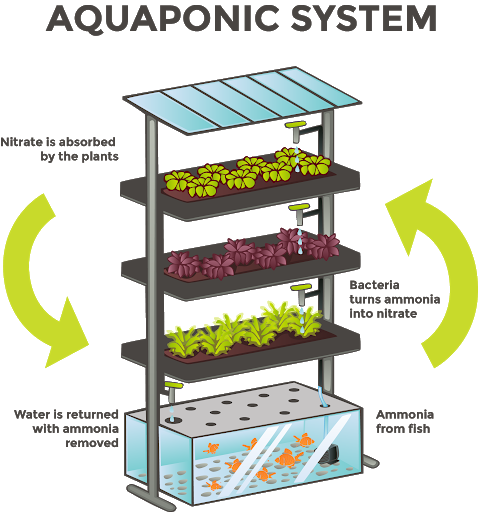Agriculture
Aquaponics Facility
- 14 Oct 2020
- 5 min read
Why in News
A pilot ‘Aquaponics facility’ has been developed by the Centre for Development of Advanced Computing (C-DAC), Mohali at Guru Angad Dev Veterinary University (GADVASU), Ludhiana.
Key Points
- State-of-the-art facility: It is equipped with advanced sensors for monitoring and automated controls of the farming system.
- The supercomputing power being provided by C-DAC in developing agriculture technology.
- Funding Support was provided by the Ministry of Electronics and Information Technology (Meity).
- Other Features:
- The facility is nearly 100% organic.
- Needs much less land for a given yield of crop.
- Consumes 90% less water.
- The fish and plants grown together are more nutritious.
- Significance:
- Demand for fishes and crops (lettuce, spinach, capsicum, coriander, broccoli and some other leafy plants) is increasing rapidly in urban areas.
- The aspirational rural youth will be drawn into the mainstream with help of this technology and agri-economy will get a boost.
- This technique will help the farmer in increasing the productivity of his land.
- Also augment farmer’s income especially in non-coastal areas.
Aquaponics
- Aquaponics is a system that combines hydroponics, soil-less agriculture, and aquaculture within a closed system.
- Hydroponics: It is a method of growing plants in a water-based, nutrient-rich solution.
- Hydroponics does not use soil, instead, the root system is supported using an inert medium such as clay pellets.
- The basic premise behind hydroponics is to allow the plant’s roots to come in direct contact with the nutrient solution, while also having access to oxygen, which is essential for proper growth.
- Aquaculture: Breeding, raising, and harvesting fish, and aquatic plants.
- Hydroponics: It is a method of growing plants in a water-based, nutrient-rich solution.
- There are three biological components in the aquaponics process: fish, plants, and bacteria (for cycling of nutrients- ammonia to nitrate conversion).
- Process:
- With aquaponics, the farmer combines the aquaculture with hydroponic vegetables – the fish waste provides fertilizer for growing plants.
- The plants absorb nutrients and filter the water. This filtered water is used to replenish the fish tank. This is an environment friendly technique.
- The result is value-added, local production of both fish and vegetables together, using the same water.
- Benefits:
- Extremely water efficient.
- Does not require soil.
- Does not use fertilizers or chemical pesticides.
- Prevents aquaculture waste from polluting nearby watersheds.
- Higher control on production leading to lower losses.
- Can be used on non-arable lands such as deserts, degraded soil or salty, sandy islands.
- While the creation of an aquaponics system may require a large initial investment, once it has been built it only incurs low recurring costs.
- In addition, aquaponics can offer quality-of-life improvements because the food is produced locally using comparatively simple harvest methods and culturally appropriate crops can be grown.
Centre for Development of Advanced Computing
- C-DAC is the premier Research & Development organization of the Ministry of Electronics and Information Technology (Meity) for carrying out R&D in IT, Electronics and associated areas.
- India's first supercomputer PARAM 8000 was indigenously built (in 1991) by the C-DAC.
- Various activities of C-DAC in the area of agriculture:
- Electronic Nose and Vision (ENOVISION) system for measuring quality parameters of tea and rice.
- This work is being extended to other products such as chilli, turmeric and to environmental engineering.
- C-DAC has also developed Wireless Data Logger used for determining the fitness of perishable agricultural items.
- Ubiquitous Agriculture (u-Agri): An Internet of Things (IoT) based system for acquiring micro-climate information from agricultural fields and providing personalized and localized advisories on Pest and Disease Forewarning and Irrigation Scheduling, to farmers.
- Electronic Nose and Vision (ENOVISION) system for measuring quality parameters of tea and rice.





